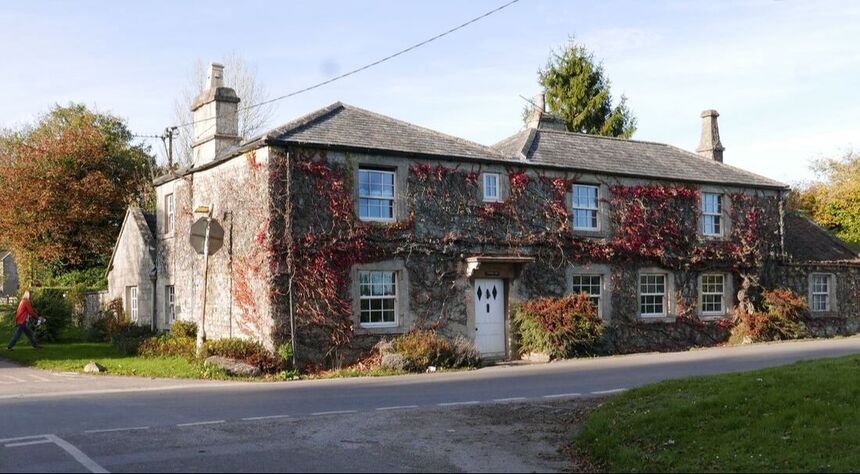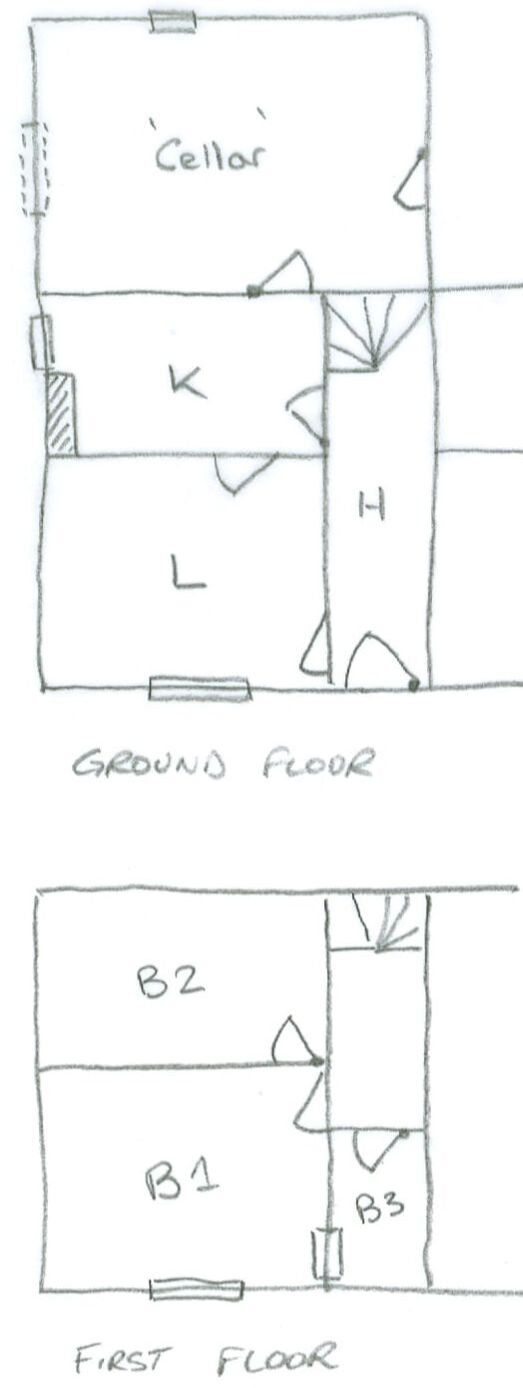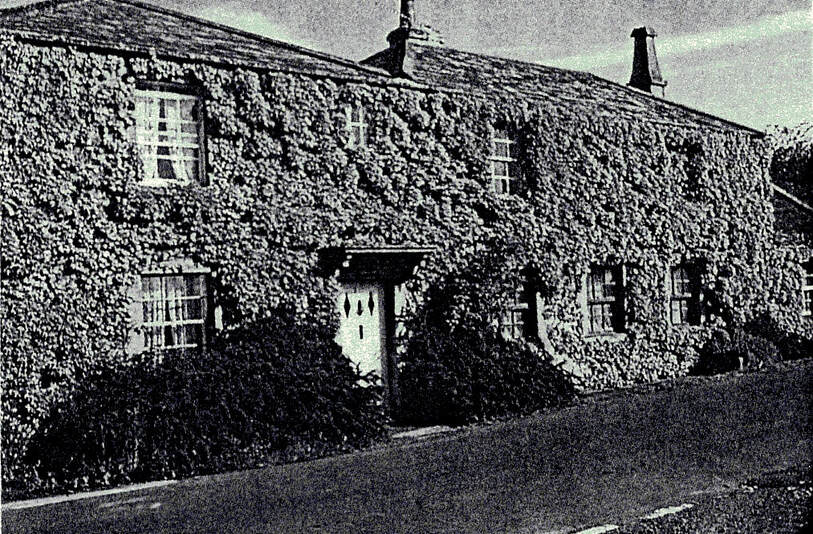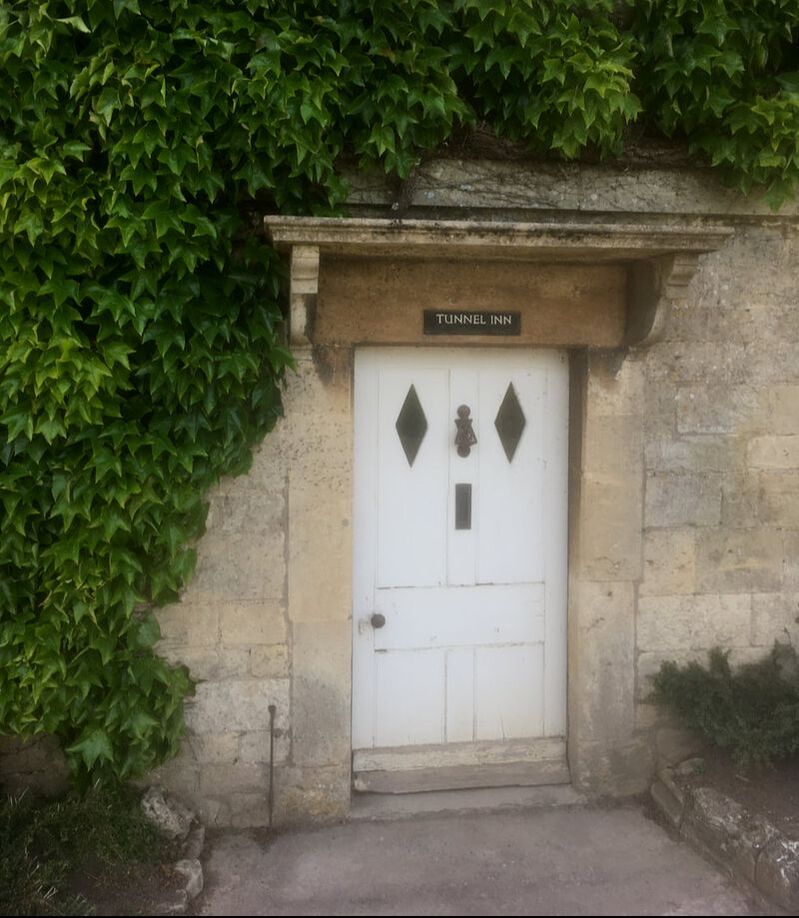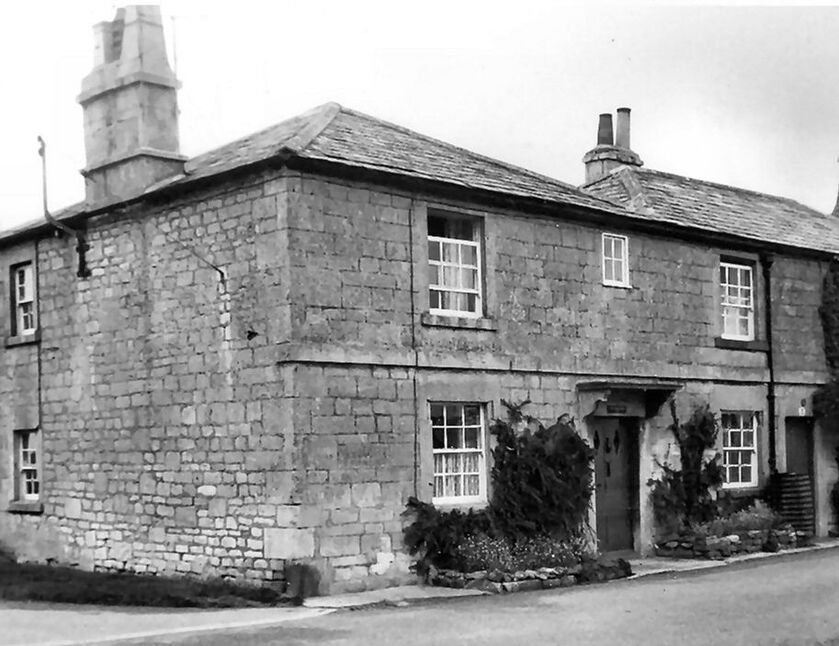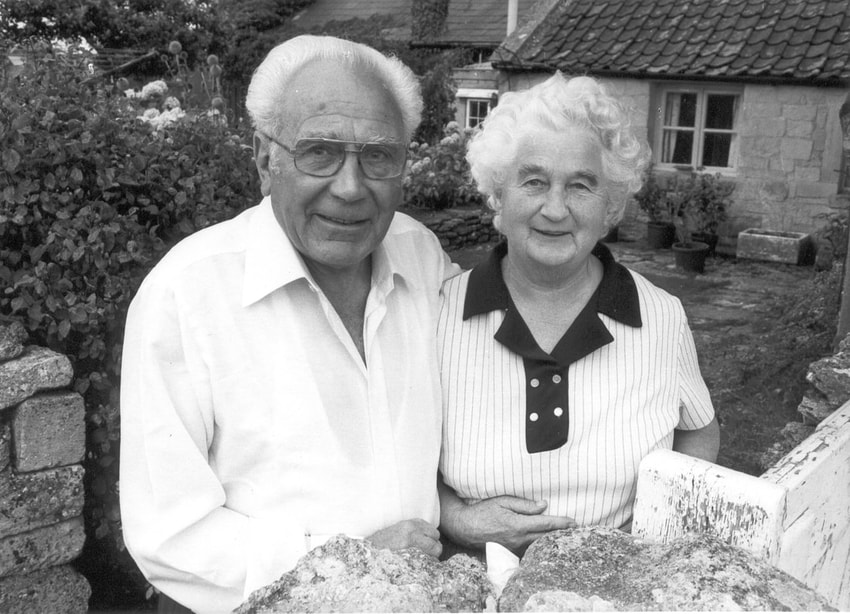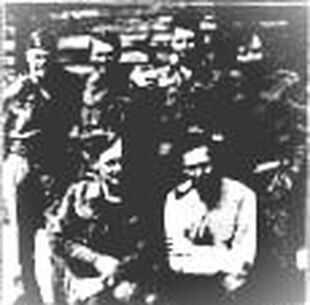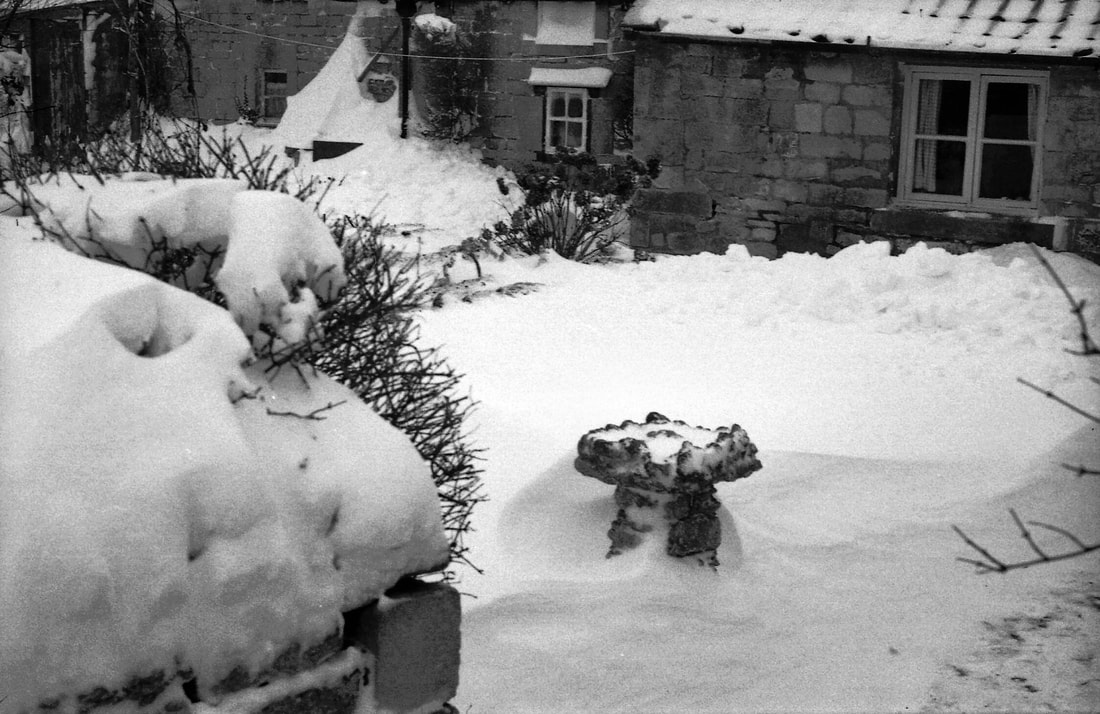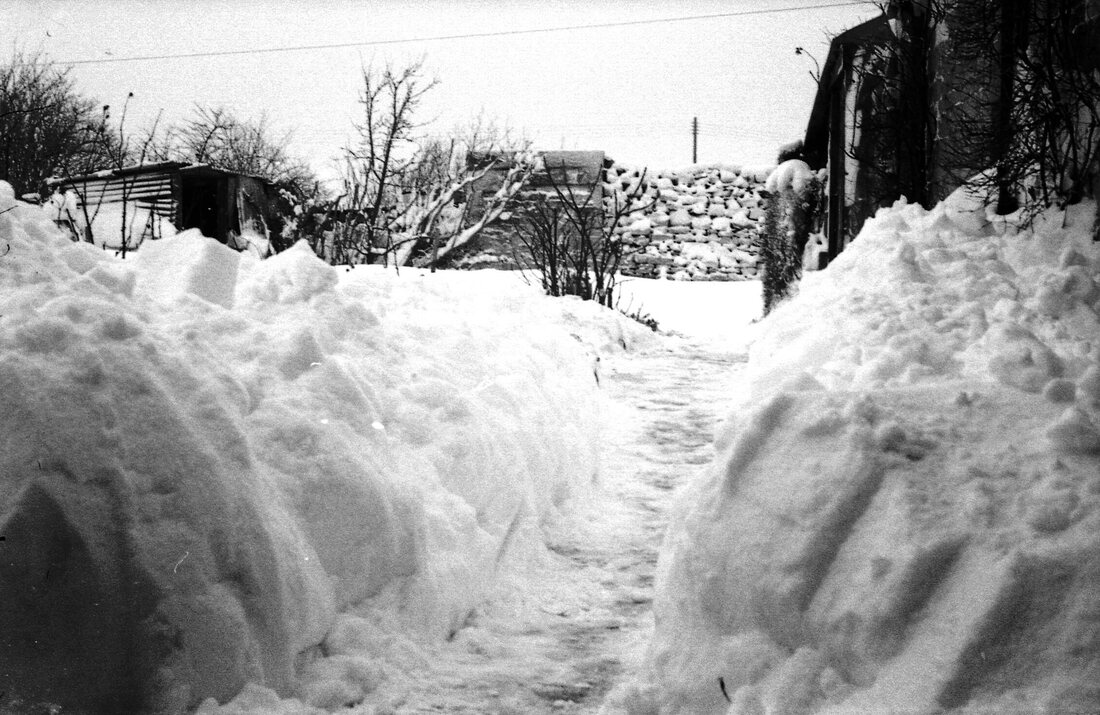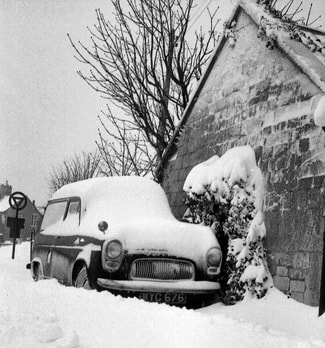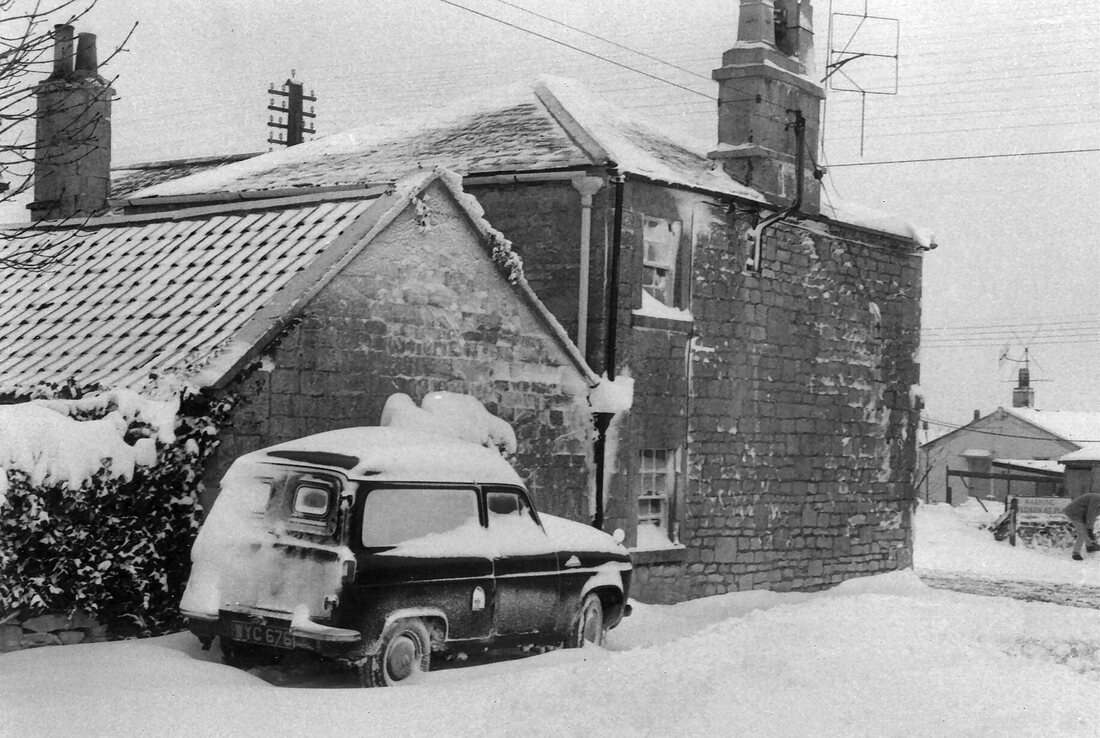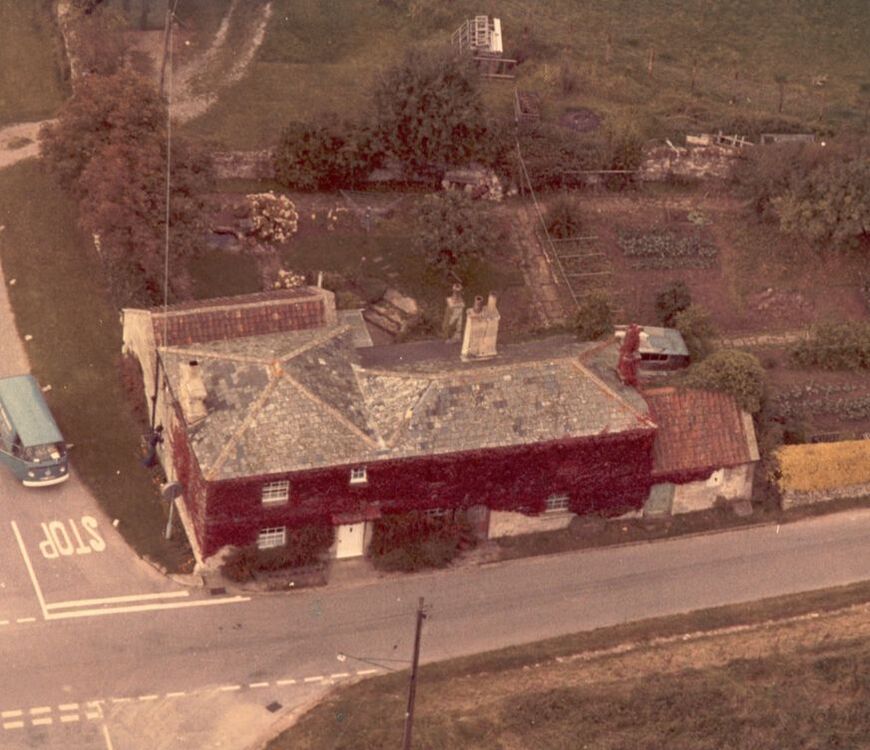Tunnel Inn and Cottages Richard Pinker & Alan Payne, October 2021
Tunnel Inn can be found on Box Hill at the cross roads of Ennox Lane and Boxfields Road not far from the filled in number 3 shaft of Brunel’s Tunnel. It formed part of the Boxfields community with the bungalows built during the war, until the mid-1960s when the latter were demolished. In its early days it was a pub.
|
Layout of the Buildings The main cottage was called Tunnel Inn or sometimes number 1 Tunnel Inn. This was the landlord's living quarters and cottages number 2 and 3 were the bar area. Above them was the guest lodgings. The cellar was in the outhouse building attached to the rear of the landlord’s quarters. In the 1940s there was still a large stone block in the cellar where the beer barrels were kept. Its delivery entrance was through a door (now a window seen in the headline photograph, which was installed in the 1950s when the outhouse was converted into a kitchen). It was thought that originally there was access to cottages 2 and 3 from the quite large hall of number 1 which seemed out of proportion for a single house. Just thinking about it, perhaps the bar was in the outhouse with a side entrance. Later the bar was along the front of the house and I remember people trying to read the licensee's details from there. It isn’t surprising that the first reference to Tunnel Inn was in 1841 when Box Tunnel was completed because the inn specifically catered for the tunnel workers. In the 1841 census, the property was identified by name probably relating to its newness rather than its quality as a drinking establishment. But it was never licensed for the general public under the terms of the Alehouse Act of 1828 or the Beer House Act of 1830. Pub in the 1840s The 1841 census listed John Neate (b 1781), publican, as the householder in the Tunnel Inn with his wife Elizabeth (1785-) and children Elizabeth (1821-), Richard (1826-) and Jane (1828-). They probably lived in a back room of the house because upstairs was a cheap lodging house (possibly a “doss” house comprising the same beds used by day-shift workers and later by the night-shift). There were six lodgers listed, all young men in their mid-20s or early-30s, referred to as Rail Labourers, in other words itinerant navvies. Tunnel Inn doesn’t appear to have been open to the public but, rather, it offered accommodation and beer for tenants. |
The adjoining properties were similarly occupied by railway navvies. Box Tunnel Cottages were on the right of the pub and the outhouse of number 3 is reputed to have been used as a mortuary for those who were killed in the excavation of Box Tunnel and later when an accident in Quarry Woods killed several quarrymen.[1] The cottages were mostly used for accommodation, just as the next-door house, called Box Tunnel Shaft in 1841, housed seven single men lodging there.
Tenants of the Pub
The property continued in use as a pub for a while after Box Tunnel was opened and the navvies were no longer required. But, as a pub, it doesn’t appear very successful and the tenant changed frequently. When John Wilkins gave a witness statement about a fatal accident in the tunnel in September 1841, he had replaced John Neate in operating the inn. Wilkins said, I am a miner. I also keep the Box Tunnel Inn, a beer-house.[2]
The property continued in use as a pub for a while after Box Tunnel was opened and the navvies were no longer required. But, as a pub, it doesn’t appear very successful and the tenant changed frequently. When John Wilkins gave a witness statement about a fatal accident in the tunnel in September 1841, he had replaced John Neate in operating the inn. Wilkins said, I am a miner. I also keep the Box Tunnel Inn, a beer-house.[2]
The inn didn't stay in his possession. By March 1842 another accident inquest heard evidence from Jacob Merchant, landlord of a beer-house near shaft number 7, concerning the death of Henry Couzens, aged 25, a watchman on GWR.[3] Jacob Merchant was just a pub landlord because a few months later a report into the state of the tunnel called him: an assistant engineer under Mr Brunel, who provided men with ladders, torches and tools.[4] It might be inferred that Jacob operated a group of labourers and other workmen, using Tunnel Inn as a base to offer beer, food and accommodation.
|
Private Residences, 1871-91 There is no specific mention of the buildings in the 1850s and 60s, possibly implying that it was no longer operating as a beer house. In 1871 three different households occupied parts of the building: Ann Newman (1798-), widow, and her brother Charles Adams (1796-), mason; Joseph Green (1831-), shepherd with his wife, step-daughter Sarah Shewring and daughter; and David Rex (1826-), agricultural labourer, with his wife and daughter. The Newman family had experience of running pubs because in the 1841 census John Newman (1795-), mason, and his wife Ann (1798-) were operating an un-named beer-house on Box Hill which could have been The Quarryman’s Arms. It is difficult to be certain as the premises appears to have operated outside of the formal licensing procedure at that time. The premises were a similar arrangement to Tunnel Inn with seven other people renting accommodation in the Beer House. By 1851 John was described as an invalid and he and Ann had moved to a property at Box Quarries. The tenancy of their pub possibly passed to Joseph Head (1785-). |
The letting of the property continued in 1881 with different people listed in the census: George Pictor, carter stone works, and his family; David Rose, agricultural labourer; and Charles Wheeler, another carter. The property was convenient for haulage, sited on a crossroads and close to the main Bradford Road. But the quarry trade was undergoing great restructuring with the formation of the amalgamated Bath Stone Firms Ltd in 1887. It is likely that small hauliers and stone carters lost business. In 1891, some of the same families were renting Tunnel Inn (called Tunnel End in the census). In number 1 was Eliza Rose, widow; in number 2 Harry Greenland, who worked at the candle factory; and in number 3 Charles Tyler, a horse driver employed by the Stone Works.
Hazell and Greenland Families
Two families – the Hazells and Greenlands – were long-term residents in the years around the First World War. Henry Hazell (1847-1925), domestic gardener, from Woolley, his wife Elizabeth (1855-) and child Emily (1873-) lived in the 4 rooms of 1 Tunnel Inn between at least 1901 and 1925. Henry was the long-term gardener at Rudloe House, Rudloe Firs, for 38 years. On his death, aged 78 in 1925, his employers Robert Wilton Tilley and wife Eleanor sent flowers with a sincere message in memory of many years’ friendship and faithful service.[5] Robert was an auctioneer and estate agent, partner in the firm of Tilley and Culverwell, Chippenham, who ran a small herd of cows whilst his daughters operated a riding school from the property.
At number 2 Tunnel Inn was the Greenland family. Previously this family had been connected with the quarrying or hostelry trade and Harry William Greenland (1857-1912) was born at the Lamb Inn, Box, son of a stone mason. In 1880 he married Ann Zebudah Hunt (1855-) and they lived near The Quarryman’s Arms, Box Hill, until they set up home at 2 Tunnel Inn from at least 1891. Harry wasn’t a publican or quarryman and instead worked all his adult life as a soap boiler at Vezey's Candle Factory on Quarry Hill until his death in 1912. Soap making was a by-product of candle manufacture whereby the fat from animal hides were separated into the two products, soap or candles. The glycerine was extracted from the soap base in a highly-dangerous process liable to cause burning on the skin or even blindness if it got into the eyes.
Harry and Ann had six children in the three-roomed property. The family were Methodists attending the United Free Church on Box Hill, although their eleven-year-old their son Albert disgraced himself by laughing and talking (during the service) and sat down and leant forward during the singing of the hymn.[6] This case was brought before the magistrates by several people including Charles Oatley (later Box Parish Council Chairman) where the magistrates used their discretion to say that there was insufficient evidence for a prosecution and issued a severe caution. After Harry’s death, Annie moved and later married Henry Simpkins in 1919. Some of the children moved to Wales but others remained locally in an adjacent property at 3 Berry Cottages.
Two families – the Hazells and Greenlands – were long-term residents in the years around the First World War. Henry Hazell (1847-1925), domestic gardener, from Woolley, his wife Elizabeth (1855-) and child Emily (1873-) lived in the 4 rooms of 1 Tunnel Inn between at least 1901 and 1925. Henry was the long-term gardener at Rudloe House, Rudloe Firs, for 38 years. On his death, aged 78 in 1925, his employers Robert Wilton Tilley and wife Eleanor sent flowers with a sincere message in memory of many years’ friendship and faithful service.[5] Robert was an auctioneer and estate agent, partner in the firm of Tilley and Culverwell, Chippenham, who ran a small herd of cows whilst his daughters operated a riding school from the property.
At number 2 Tunnel Inn was the Greenland family. Previously this family had been connected with the quarrying or hostelry trade and Harry William Greenland (1857-1912) was born at the Lamb Inn, Box, son of a stone mason. In 1880 he married Ann Zebudah Hunt (1855-) and they lived near The Quarryman’s Arms, Box Hill, until they set up home at 2 Tunnel Inn from at least 1891. Harry wasn’t a publican or quarryman and instead worked all his adult life as a soap boiler at Vezey's Candle Factory on Quarry Hill until his death in 1912. Soap making was a by-product of candle manufacture whereby the fat from animal hides were separated into the two products, soap or candles. The glycerine was extracted from the soap base in a highly-dangerous process liable to cause burning on the skin or even blindness if it got into the eyes.
Harry and Ann had six children in the three-roomed property. The family were Methodists attending the United Free Church on Box Hill, although their eleven-year-old their son Albert disgraced himself by laughing and talking (during the service) and sat down and leant forward during the singing of the hymn.[6] This case was brought before the magistrates by several people including Charles Oatley (later Box Parish Council Chairman) where the magistrates used their discretion to say that there was insufficient evidence for a prosecution and issued a severe caution. After Harry’s death, Annie moved and later married Henry Simpkins in 1919. Some of the children moved to Wales but others remained locally in an adjacent property at 3 Berry Cottages.
Pinker Family
The Pinker family moved to 1 Tunnel Inn when Alfred Pinker retired as a coachman and later taxi driver in the 1930s. Tunnel Inn was owned by Fred Neate who had bought substantial Box Hill land from the Northey estate. Alfred’s son and daughter-in-law, Aubrey and Nellie, moved into the property around 1946 to look after Alfred’s widow Rhoda Ann (nee Oatley). They lived there for over thirty years and celebrated their golden wedding there in 1979.
The Pinker family moved to 1 Tunnel Inn when Alfred Pinker retired as a coachman and later taxi driver in the 1930s. Tunnel Inn was owned by Fred Neate who had bought substantial Box Hill land from the Northey estate. Alfred’s son and daughter-in-law, Aubrey and Nellie, moved into the property around 1946 to look after Alfred’s widow Rhoda Ann (nee Oatley). They lived there for over thirty years and celebrated their golden wedding there in 1979.
Aubrey and Nellie Pinker were both Box Parish councillors, Aubrey serving as vice-chairman 1972-75 and also on the Calne and Chippenham Rural District Council. They fiercely opposed the destruction of the quarries and the aggregation of open-cast quarry spoil on Box Hill Common in the 1970s. They tried to instigate a museum to recall the industry but, unfortunately, the quarry shafts were filled in with rubble from the demolished Boxfield bungalows. Subsequent residents have learnt to regret the eradication of the entire industry from public view.
Sad Remembrances
Other families came to the cottages around the Second World War. The Wilkins family were local to Box, living at Wadswick for many years where the family were farm labourers living in tied accommodation near Chapel Plaister. By 1891 Nathaniel (1854-1929) and his wife Emily (1856-) had settled in tenanted accommodation at 8 Boxfields where Nathaniel was still working on a farm as a carter and they had at least five children, including two, William and Emily, named after their parents. But in July 1908, the Bath and Portland Stone Firms, the owner of Boxfields, put the whole rank up for sale and the Wilkins were only on a monthly-renewing tenancy. We might imagine their relief when local Box Hill residents, the Neate family, bought the whole rank of Boxfield Cottages and it was the start of decades of association between tenant and landlord.
When Nathaniel retired around the First World War, the couple moved out of Boxfields to another property owned by Fred Neate, number 2 Tunnel Inn where they lived until a great tragedy in 1929. On 19 March 1929 Nathaniel Wilkins, aged 74, died at 2 Tunnel Inn Cottages and four days later his wife Emily Alma died aged 72. It was devastating for the family and for many years afterwards they put memorial notices in the local papers, expressing their sorrow and confirming that the couple were in death not divided.[7] Two of the children continued the tenancy and William Wilkins (1 August 1887-) and his sister Emily (23 April 1886-) lived in 3 rooms at number 3 Tunnel Inn. Bill was a county road worker, employed by Wiltshire County Council to maintain parts of the road surface.
Other families came to the cottages around the Second World War. The Wilkins family were local to Box, living at Wadswick for many years where the family were farm labourers living in tied accommodation near Chapel Plaister. By 1891 Nathaniel (1854-1929) and his wife Emily (1856-) had settled in tenanted accommodation at 8 Boxfields where Nathaniel was still working on a farm as a carter and they had at least five children, including two, William and Emily, named after their parents. But in July 1908, the Bath and Portland Stone Firms, the owner of Boxfields, put the whole rank up for sale and the Wilkins were only on a monthly-renewing tenancy. We might imagine their relief when local Box Hill residents, the Neate family, bought the whole rank of Boxfield Cottages and it was the start of decades of association between tenant and landlord.
When Nathaniel retired around the First World War, the couple moved out of Boxfields to another property owned by Fred Neate, number 2 Tunnel Inn where they lived until a great tragedy in 1929. On 19 March 1929 Nathaniel Wilkins, aged 74, died at 2 Tunnel Inn Cottages and four days later his wife Emily Alma died aged 72. It was devastating for the family and for many years afterwards they put memorial notices in the local papers, expressing their sorrow and confirming that the couple were in death not divided.[7] Two of the children continued the tenancy and William Wilkins (1 August 1887-) and his sister Emily (23 April 1886-) lived in 3 rooms at number 3 Tunnel Inn. Bill was a county road worker, employed by Wiltshire County Council to maintain parts of the road surface.
|
By the 1940s, Mr and Mrs Thomas Rogers lived at number
2 Tunnel Inn. Thomas Rodgers (4 April 1892-) was a foreman of labour in stone quarry, and he worked for the Royal Engineers, Corsham, during the Second World War. In 1941, a fascinating notice and this photograph was placed in newspapers by Mrs T Rodgers of 2 Tunnel Inn, Box Hill.[8] Her son Private JG Rodgers was a prisoner-of-war in Germany along with various servicemen from Derbyshire. She attached the photograph so that the Derbyshire families of the prisoners should know they were alive and well. Thomas’ wife Nellie (27 March 1890-) continued to live there with their daughter Florrie (28 October 1923-), laundry worker, into the 1950s. |
Above: Tunnel Inn back garden in 1962-63 and Below: Vehicle access to the area severely restricted for weeks because of the Big Freeze .
Photographs courtesy Richard Pinker.
Photographs courtesy Richard Pinker.
Modern History of the House
Tunnel Inn (described as three period cottages 1, 2 and 3 Tunnel Inn Cottages part attractively clad in Virginia Creeper) was put up for sale in about 1975.[10] Number 1 was let to Aubrey and Nellie Pinker and numbers 2 and 3 had been partly modernised and converted into a single premises, at that date untenanted. The house was bought by Clive and Frank Freeman in about 1979, when it still retained its old and quirky inside with lots of nooks and crannies. A very old revolver was found inside a very old bread oven in the early years.
Tunnel Inn (described as three period cottages 1, 2 and 3 Tunnel Inn Cottages part attractively clad in Virginia Creeper) was put up for sale in about 1975.[10] Number 1 was let to Aubrey and Nellie Pinker and numbers 2 and 3 had been partly modernised and converted into a single premises, at that date untenanted. The house was bought by Clive and Frank Freeman in about 1979, when it still retained its old and quirky inside with lots of nooks and crannies. A very old revolver was found inside a very old bread oven in the early years.
Tunnel Inn and Cottages have an intriguing history. They were some of the very few ordinary buildings to be named in the 1841 census, most being referred to simply as a cottage until the twentieth century. But the name is curious as the building was used as a private residence for most of its nearly 200-year history and existed as a pub for only a decade or so. Tunnel Inn is a marvellous example of a curious anomaly.
Occupants of Tunnel Inn and Cottages
1871 Tunnel Inn: Ann Newman (1798-), widow, and her brother Charles Adams (1796-), mason;
Tunnel Inn: Joseph Green (1831-), shepherd with his wife, step-daughter Sarah Shewring and daughter;
Tunnel Inn: David Rex (1826-), agricultural labourer, with his wife Eliza (1827-) and daughter
1881 Tunnel Inn: George Fido (1830-), carter or cutter stone works, and his wife Harriett Sheppard (1834-) and two relatives;
Tunnel Inn: David Rex (1826-), agricultural labourer; and his wife Eliza (1829-)
Tunnel Inn: Charles Wheeler (1851-), another carter, his wife Eliza (1853-) and 3 children.
1891 1 Tunnel End: Eliza Rex, widow;
2 Tunnel End: Harry Greenland, who worked at the candle factory;
3 Tunnel End: Charles Tyler (1852-), a horse driver employed by the Stone Works.
1901 Tunnel End: Henry Hazell (1847-1925), his wife Elizabeth (1855-) and child Emily (1873-).
Tunnel End: Harry H Greenland (1857-), soap boiler and his wife Ann (1855-). Children Arthur (1883-), stone quarryman miner, Albert (1889-), Evelyn (1893-), Lucy (1895-).
Tunnel End: Charles Tyler (1852-), stone quarryman miner, and his wife Ann (1855-) and children Charles Herbert (1884-), stone quarryman miner, Ernest (1889-), Vina Elizabeth (1892-)
1911 1 Tunnel Inn (4 rooms): Henry Hazell (1847-1925), domestic gardener, from Woolley, his wife Elizabeth (1855-) and child Emily (1873-). Henry was the gardener at Rudloe House, Rudloe Firs for 38 years. On his death in 1925, his employers Robert Wilton and Eleanor Tilley sent flowers in memory of many years’ friendship and faithful service.[9] Robert was an auctioneer and estate agent, of the firm of Tilley and Culverwell, Chippenham.
2 Tunnel Inn (3 rooms): Harry H Greenland (1857-), soap boiler and his wife Ann (1855-)
3 Tunnel Inn: Charles Tyler (1852-), general labourer, and his wife Ann (1855-)
1939 1 Tunnel Inn: Alfred Pinker (5 December 1869-1944), taxi driver (retired) old age pensioner, his wife Rhoda A (23 April 1866-1948). There were 3 lodgers, 2 single men working as carpenters on government works (clearing the tunnels) and one domestic helper.
2 Tunnel Inn: Thomas Rodgers (4 April 1892-), foreman of labour in stone quarry, working for Royal Engineers, Corsham, his wife Nellie (27 March 1890-) and child Florrie (28 October 1923-), laundry worker.
3 Tunnel Inn: William Wilkins (1 August 1887-), county road worker, and his sister Emily (23 April 1886-).
1871 Tunnel Inn: Ann Newman (1798-), widow, and her brother Charles Adams (1796-), mason;
Tunnel Inn: Joseph Green (1831-), shepherd with his wife, step-daughter Sarah Shewring and daughter;
Tunnel Inn: David Rex (1826-), agricultural labourer, with his wife Eliza (1827-) and daughter
1881 Tunnel Inn: George Fido (1830-), carter or cutter stone works, and his wife Harriett Sheppard (1834-) and two relatives;
Tunnel Inn: David Rex (1826-), agricultural labourer; and his wife Eliza (1829-)
Tunnel Inn: Charles Wheeler (1851-), another carter, his wife Eliza (1853-) and 3 children.
1891 1 Tunnel End: Eliza Rex, widow;
2 Tunnel End: Harry Greenland, who worked at the candle factory;
3 Tunnel End: Charles Tyler (1852-), a horse driver employed by the Stone Works.
1901 Tunnel End: Henry Hazell (1847-1925), his wife Elizabeth (1855-) and child Emily (1873-).
Tunnel End: Harry H Greenland (1857-), soap boiler and his wife Ann (1855-). Children Arthur (1883-), stone quarryman miner, Albert (1889-), Evelyn (1893-), Lucy (1895-).
Tunnel End: Charles Tyler (1852-), stone quarryman miner, and his wife Ann (1855-) and children Charles Herbert (1884-), stone quarryman miner, Ernest (1889-), Vina Elizabeth (1892-)
1911 1 Tunnel Inn (4 rooms): Henry Hazell (1847-1925), domestic gardener, from Woolley, his wife Elizabeth (1855-) and child Emily (1873-). Henry was the gardener at Rudloe House, Rudloe Firs for 38 years. On his death in 1925, his employers Robert Wilton and Eleanor Tilley sent flowers in memory of many years’ friendship and faithful service.[9] Robert was an auctioneer and estate agent, of the firm of Tilley and Culverwell, Chippenham.
2 Tunnel Inn (3 rooms): Harry H Greenland (1857-), soap boiler and his wife Ann (1855-)
3 Tunnel Inn: Charles Tyler (1852-), general labourer, and his wife Ann (1855-)
1939 1 Tunnel Inn: Alfred Pinker (5 December 1869-1944), taxi driver (retired) old age pensioner, his wife Rhoda A (23 April 1866-1948). There were 3 lodgers, 2 single men working as carpenters on government works (clearing the tunnels) and one domestic helper.
2 Tunnel Inn: Thomas Rodgers (4 April 1892-), foreman of labour in stone quarry, working for Royal Engineers, Corsham, his wife Nellie (27 March 1890-) and child Florrie (28 October 1923-), laundry worker.
3 Tunnel Inn: William Wilkins (1 August 1887-), county road worker, and his sister Emily (23 April 1886-).
Greenland Family Tree
Harry William Greenland (1857-1912) married Ann Zebudah Hunt (1855-). Children:
Thomas (1881-); Arthur William (1883-) who married Sarah Ann Wilkins in 1901; Albert Henry (1889-) married Frances Elizabeth Phelps in Box in 1909; Evelyn (1893-); Lucy (1895-); Francis William (1902-).
Harry William Greenland (1857-1912) married Ann Zebudah Hunt (1855-). Children:
Thomas (1881-); Arthur William (1883-) who married Sarah Ann Wilkins in 1901; Albert Henry (1889-) married Frances Elizabeth Phelps in Box in 1909; Evelyn (1893-); Lucy (1895-); Francis William (1902-).
References
[1] Courtesy Richard Pinker and Robert Coles
[2] The Bath Chronicle, 23 September 1841
[3] The Bath Chronicle, 31 March 1842
[4] The Bath Chronicle, 9 August 1842
[5] Wiltshire Times and Trowbridge Advertiser, 3 January 1925
[6] The Wiltshire Times, 21 April 1900
[7] Wiltshire Times and Trowbridge Advertiser, 30 March 1929
[8] Derbyshire Times and Chesterfield Herald, 26 September 1941
[9] Wiltshire Times and Trowbridge Advertiser, 3 January 1925
[10] Sale Particulars, Crisp Cowley about 1975
[1] Courtesy Richard Pinker and Robert Coles
[2] The Bath Chronicle, 23 September 1841
[3] The Bath Chronicle, 31 March 1842
[4] The Bath Chronicle, 9 August 1842
[5] Wiltshire Times and Trowbridge Advertiser, 3 January 1925
[6] The Wiltshire Times, 21 April 1900
[7] Wiltshire Times and Trowbridge Advertiser, 30 March 1929
[8] Derbyshire Times and Chesterfield Herald, 26 September 1941
[9] Wiltshire Times and Trowbridge Advertiser, 3 January 1925
[10] Sale Particulars, Crisp Cowley about 1975
